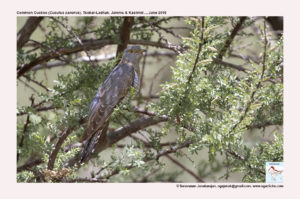Common Cuckoo

Common Cuckoo / Eurasian Cuckoo Cuculus canorus
Etymology:
- Cuculus : Latin word for Cuckoo
- Canorus: Latin word for Melodious
Vernacular Names: Kash: Hor kuk, Shakuk, Kuku, Kukil, U.P.: Phuphu, Kupwah, Lepcha: Kukku, Bhutia: Akku, Khasia: Kuku, Guj: Pardeshi kukanth, Kuhukanth, Hindi: Pahadi Kuku, Mar: Samanya Kokil
Distribution in India: Breeds in Himalayas, North, Central and North East India.
Description: Size of 32–34 cm; wt. of male is 114–133 g, wt. of female is 106–112 g. The adult male is dark ashy-grey above; tail is blackish brown, spotted and tipped with white, unevenly barred black; chin to breast is ashy grey, rest of underparts are white with black bars; eyering is yellow, iris is light brown to orange, bill is black with yellow base, feet is yellow. The female is similar, but has rufous-tinged upper breast; the female of race canorus also occurs in a rufous (“hepatic”) morph, with upperparts barred chestnut and blackish brown, rump and uppertail-coverts are plain rufous, underparts are white barred pale chestnut and blackish, lower breast are tinged rufous. The juvenile has white nape spot, white tips to crown and back feathers. The race subtelephonus is pale, black bars below narrow; race bakeri is darker grey than canorus; race bangsi is smaller, females often with much rufous on breast.
Habitat: It is found in forests and woodlands, both coniferous and deciduous, second growth, open wooded areas, wooded steppe, scrub, heathland, also meadows, reedbeds. It is found in lowlands and moorlands and hill country up to 3800 m.
Food habits: When on land it eats insects, mainly caterpillars, dragonflies, damselflies, mayflies, crickets, cicadas; beetles in cold weather upon spring arrival on North breeding grounds; also spiders, snails and rarely fruit. It preys on eggs and nestlings of small birds. The female may forage 2–3 km from laying sites; male feeds at up to 4 km from singing site
Breeding habits: They breed in May–Jun in UK and in North West Europe, Apr–May in Algeria and Apr–Jul in India and Myanmar. They are brood-parasitic: the hosts include many insectivorous songbird species like flycatchers, chats, warblers, pipits, wagtails and buntings. Some species only occasionally parasitized, but still raise young cuckoo. They are often mobbed by real or potential hosts near their nests. The eggs are polymorphic in colour (blue, pink, whitish) and pattern (spotted or unmarked) so that the eggs closely match those of host in colour and pattern. The egg mimicry to different host species can be explained by the existence of female-specific lineages of cuckoos, called “gentes or singular gens”. The egg mimicry includes not only background and spot colours, but also egg size. The incubation period is 11-12 days. The nestling period is 17–18 days. They evict host’s eggs and chicks. The chicks fledge and are fed by foster parents for another 2–3 weeks. The chicks, when threatened, expel dark foul-smelling liquid from their cloaca, its repellent effect being especially intensive on mammalian predators.